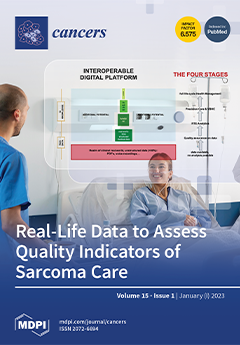Background and aims: International guidelines recommend testing
BRCA2 in men with prostate cancer, due to the presence of a strong association with this gene. Some ethnicities present disparities in genetic distribution for the relation with specific founder variants. Ashkenazi Jewish people are, importantly,
[...] Read more.
Background and aims: International guidelines recommend testing
BRCA2 in men with prostate cancer, due to the presence of a strong association with this gene. Some ethnicities present disparities in genetic distribution for the relation with specific founder variants. Ashkenazi Jewish people are, importantly, at high risk of breast cancer for their inherited cluster with germline
BRCA1/2 variants. However, in Ashkenazi men with prostate cancer, the prevalence of
BRCA1 and/or
BRCA2 is not well defined. We assessed the frequency of these variants in Ashkenazi vs. non-Ashkenazi men with prostate cancer.
Materials and Methods: In accord with the Preferred Reporting Items for Systematic reviews and Meta-Analyses (PRISMA) statement, we revised all germline
BRCA variants reported in MEDLINE from 1996 to 2021 in Ashkenazi and non-Ashkenazi men with prostate cancer.
Results: Thirty-five original studies were selected for the analysis. Among populations from Israel and North America, Ashkenazi Jewish men presented higher prevalence of
BRCA1 variants [0.9% (0.4–1.5) vs. 0.5% (0.2–1.1),
p = 0.09] and a lower prevalence of
BRCA2 variants [1.5% (1.1–2.0) vs. 3.5% (1.7–5.9),
p = 0.08] in comparison to the non-Ashkenazi population.
Conclusions: Since germline
BRCA1 variants are more prevalent and
BRCA2 variants are less prevalent in PCa patients of Ashkenazi Jewish ethnicity in comparison to non-Ashkenazi patients, prostate cancer genetic screening in Ashkenazi men should not be restricted to the
BRCA2 gene.
Full article






